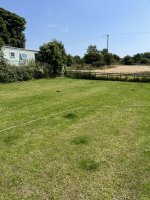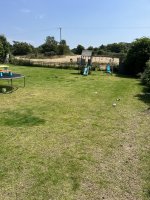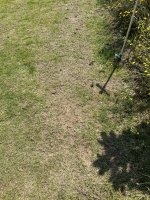It seems from the pictures like it is very sunny & you have kids which makes me think this is high traffic. I also see it is cut very short with no shade trees & full sun with unknown sprinkler set up... possible pets? This is a monoculture lawn. All of these things are problematic when you don't take them into account. You are also trying to remedy the situation with a lot of chemical & industrial solutions like the bird repellant which sometimes can can be a waste of money & lessen germination rates. Grasses come from a meadow, or prairie &, like all plants, thrive better in a mixed plant ecosystem rather than a monoculture field. If you will only grow one type of grass in a monoculture lawn, you always have to do the work to add soil amendments & maintenance & it will always be labor intensive. A polly culture lawn seeds several grass types ideal for your climate & the location and allows certain desireable weeds like dandilion, clover, dichondra, or other ground covers to grow in where the grass struggles. These other plants provide neutrients to the soil & remove toxins from the soil that the grass can't process. So, for instance, if you have cats or dogs peeing on the grass, the urea & nitrogen will be concentrated & hot which burns the lawn & can't go anywhere to dilute when watered, because the surface is level. If you fertalize and have no shade trees or top soil this will also burn & bake the existing seed and grass. If you have kids or high traffic, the tender new shoots will be trampled under before they can set. If you mow too soon & too close to the ground, you suck up & kill all the seed & stress the existing struggling lawn. So what I would recommend is buying a garden fork hoe & possibly a tool like a pitch fork that can create some holes and aeration in the soil. Buy a bale of meadowgrass hey (not other hey) & potting soil. Buy a back & forth sprinkler that can be attatched to a hose & a timer. Buy a bag of seed from a smaller nursery or online that is a custom blend of grasses without any chemicals or additives, just natural. I could better recommend grass if I knew your state or general climate. I personally have several lawn ecosystems & my full sun one is red & white clover, blue grass, rye, & dandilion. You could also try fescue added in. It does create a mixed plant & longer low mow look, but its more sustainable. So you poke holes in the lawn you have & use the forked hoe to scarify the ground as best you can. Toss the meadowgrass hey down into the patchy lawn spots. This is to help provide shade & protection to soil life. Spread the seed thickly over the entire lawn, but esspecially in the problematic areas. Spread the potting soil (I use G&B) in at least a quarter inch thick layer in the problem areas & sprinkle for neutrients on the rest of the struggling lawn thinly. Water in thoroughly with the back & forth sprinkler; likely will need 2x per day watering in the summer & 1x per day wattering in spring & fall depending on your climate. Really saturate the problem areas to try to dilute any chemicals in the soil without washing the seed away. The top soil will help deter birds from seeing or eating up your seed, but I usually just plan to reseed in a month in case. I also have a cat, & dogs which keep them away from the lawn. Grass takes 7 to 14 days to germinate & needs a lot of water. If it goes too dry, or the soil is too compact it won't set root. Do not walk on it or mow it for quite a while. The new blades will take a full 3 or 4 months before they really can be walked on & the grass needs to really establish imo for a full year cycle with seeding & dormancy before you mow. Only really established lawn with some reprieve from the sun can tollerate being mowed as low as what is shown in the pictures. Usually you mow only to the longest setting on the mower and that is only a couple times a year once established. That is healthier for the lawn, until there is a very thick root mat with soil built up & you leave the leaf scrap down to create the soil. Water always pools & runs in little rivulets in lawns. You will always have problematic areas the grass grows around. These can be filled in year 2 with soil & more seed to fill in the patches, but it is easier to just place another ground cover here that likes the runoff of undesireable chemicals the grass exhausts, or can't eat from animal waste. Prefferably a nitrogen producing legume, or calcium fixing pioneer deep taproot plant, or low growing ground cover. A couple times a year when its not hot out I make chicken maneur tea with water in a bucket & fertalize my lawns. I plant shade trees, understory & bushes around the edges to help the lawn not get burned & need less water. I let the leaf litter stay on top of the grass all winter long for protection from the frost. I inoculate the lawn with beneficial microbes, nematodes & earthworms. I keep it low traffic, until it establishes & use the excess clippings to feed my chickens, goats, & pigs. The honey bees love the clover & I let it grow long and cycle in waves with the grass to go to seed before I mow it. The clover is up in the spring and grass thrives in the summer and fall. I allow mosses and other ground covers to fill the natural cracks & dips in the land or the shady edges along with the dandilion & other herbs. My lawn is longer than most city homes, low mow, but happy & pretty.





